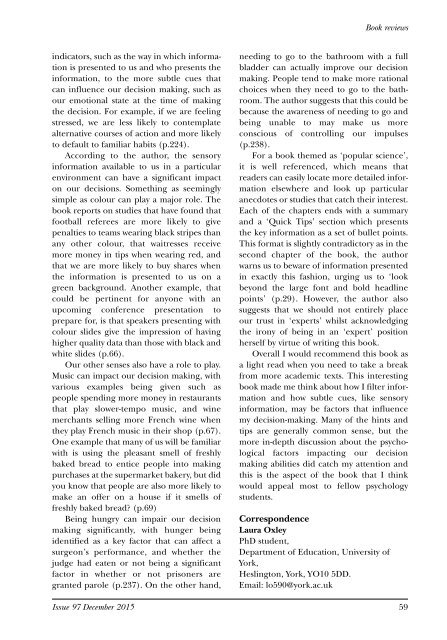Social Psychology Special Issue
PsyPAG-Quarterly-Issue-973
PsyPAG-Quarterly-Issue-973
Create successful ePaper yourself
Turn your PDF publications into a flip-book with our unique Google optimized e-Paper software.
Book reviews<br />
indicators, such as the way in which information<br />
is presented to us and who presents the<br />
information, to the more subtle cues that<br />
can influence our decision making, such as<br />
our emotional state at the time of making<br />
the decision. For example, if we are feeling<br />
stressed, we are less likely to contemplate<br />
alternative courses of action and more likely<br />
to default to familiar habits (p.224).<br />
According to the author, the sensory<br />
information available to us in a particular<br />
environment can have a significant impact<br />
on our decisions. Something as seemingly<br />
simple as colour can play a major role. The<br />
book reports on studies that have found that<br />
football referees are more likely to give<br />
penalties to teams wearing black stripes than<br />
any other colour, that waitresses receive<br />
more money in tips when wearing red, and<br />
that we are more likely to buy shares when<br />
the information is presented to us on a<br />
green background. Another example, that<br />
could be pertinent for anyone with an<br />
upcoming conference presentation to<br />
prepare for, is that speakers presenting with<br />
colour slides give the impression of having<br />
higher quality data than those with black and<br />
white slides (p.66).<br />
Our other senses also have a role to play.<br />
Music can impact our decision making, with<br />
various examples being given such as<br />
people spending more money in restaurants<br />
that play slower-tempo music, and wine<br />
merchants selling more French wine when<br />
they play French music in their shop (p.67).<br />
One example that many of us will be familiar<br />
with is using the pleasant smell of freshly<br />
baked bread to entice people into making<br />
purchases at the supermarket bakery, but did<br />
you know that people are also more likely to<br />
make an offer on a house if it smells of<br />
freshly baked bread? (p.69)<br />
Being hungry can impair our decision<br />
making significantly, with hunger being<br />
identified as a key factor that can affect a<br />
surgeon’s performance, and whether the<br />
judge had eaten or not being a significant<br />
factor in whether or not prisoners are<br />
granted parole (p.237). On the other hand,<br />
needing to go to the bathroom with a full<br />
bladder can actually improve our decision<br />
making. People tend to make more rational<br />
choices when they need to go to the bathroom.<br />
The author suggests that this could be<br />
because the awareness of needing to go and<br />
being unable to may make us more<br />
conscious of controlling our impulses<br />
(p.238).<br />
For a book themed as ‘popular science’,<br />
it is well referenced, which means that<br />
readers can easily locate more detailed information<br />
elsewhere and look up particular<br />
anecdotes or studies that catch their interest.<br />
Each of the chapters ends with a summary<br />
and a ‘Quick Tips’ section which presents<br />
the key information as a set of bullet points.<br />
This format is slightly contradictory as in the<br />
second chapter of the book, the author<br />
warns us to beware of information presented<br />
in exactly this fashion, urging us to ‘look<br />
beyond the large font and bold headline<br />
points’ (p.29). However, the author also<br />
suggests that we should not entirely place<br />
our trust in ‘experts’ whilst acknowledging<br />
the irony of being in an ‘expert’ position<br />
herself by virtue of writing this book.<br />
Overall I would recommend this book as<br />
a light read when you need to take a break<br />
from more academic texts. This interesting<br />
book made me think about how I filter information<br />
and how subtle cues, like sensory<br />
information, may be factors that influence<br />
my decision-making. Many of the hints and<br />
tips are generally common sense, but the<br />
more in-depth discussion about the psychological<br />
factors impacting our decision<br />
making abilities did catch my attention and<br />
this is the aspect of the book that I think<br />
would appeal most to fellow psychology<br />
students.<br />
Correspondence<br />
Laura Oxley<br />
PhD student,<br />
Department of Education, University of<br />
York,<br />
Heslington, York, YO10 5DD.<br />
Email: lo590@york.ac.uk<br />
<strong>Issue</strong> 97 December 2015 59


